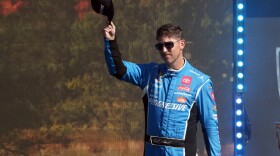This story originally appeared on WUNC's podcast The Broadside, which takes a weekly look at stories happening in North Carolina and the American South. Listen and subscribe for more reporting like this.
During the second to last NASCAR race of the regular season in 2022, driver Ross Chastain was in 10th place. As the race entered the home stretch, he was desperate to finish higher in the standings so he could make the cut for the playoffs.
So on the final turn, of the final lap he did something shocking.
Instead of hitting the breaks like everybody else in the turn, Chastain slammed his car into the side of the wall at full speed and blew past five other drivers at the finish line.
The car was destroyed, but he advanced to the final round.
That was "the Wall Ride."
"So the Wall Ride, in video game land, you put your car right up against the wall and just gas it," said Ray Smith, NASCAR’s Director of Gaming & Esports.
The wall ride is a strategy drivers have used for decades — in video games.
"And [we] never thought it could be done in real life. And Ross Chastain pulled off one of the most iconic moves in motorsports."
Closing the gap
Iconic, incredibly dangerous and now officially banned in the sport, it was clear to Smith that day — and everyone else watching — that the virtual world had crossed over to the real world in dramatic fashion.
But behind the scenes, video games and simulators have been reshaping motorsports for a while.
21-year-old NASCAR Craftsman Truck Series driver Rajah Caruth is a testament to that.
Caruth has a very untraditional background for a NASCAR driver. He’s one of only a handful of Black men on pit row. Most of his peers are white and a lot of them come from racing families with long lineages, many with roots in the South. In contrast, Caruth was raised in Washington, D.C., and no one else in his family has ever raced cars.

"So, I grew up being a fan, watching races on TV, on YouTube, playing NASCAR video games," he said. "[I] got my first real life start when I was 17, so really late compared to everybody else I race against."
Most of his competitors began organized racing with go-karts when they were 6 or 7 years old. Caruth closed that gap with the help of a hyper realistic racing simulator game called iRacing.
"I saw iRacing at first and was like 'This is just the next video game,'" he recalled.
But then something big happened. When Caruth was a sophomore in high school, a fellow iRacing gamer named William Byron signed a NASCAR Cup Series contract to race real stock cars at the highest level of the sport.
"And really, that was a moment that I realized ‘Well, this is my chance.’ And I've always wanted to race, and I knew this is what I want my career to be and my life's work," he said. "So that was my one shot."
Caruth trained obsessively on the game and became a dominant driver online. From there he was identified by a NASCAR developmental program and got a chance to race real cars in some lower-level competitions. He’s now part of a small, but growing, group of professional drivers who started their careers virtually.
"That's just not realistic for 99% of the people in the world."

With most sports, like soccer or football, video games can't prepare people to play in the real world at a high level, but motorsports appear to be an exception.
"There isn't really a sport that I can think of that more closely represents the real action to the virtual one," said Steve Myers, an Executive at iRacing.
The mechanical nature of race car driving means that gamers build skills that can potentially bridge those two worlds.
"You're using the same hand inputs [in the game], you're using the same foot movements. All of the same mechanical functions that you have to race in the real world you're doing in the [simulator] as well," said Myers.
Developers have spent decades improving the graphics and the code in games like iRacing. They’ve gotten to a point where the gameplay experience is a pretty close match to the real world physics of a race. To further heighten the realism, people are pairing the games with simulator rigs that include physical things like steering wheels, pedals and gear shifts. The most complicated versions look like something from an amusement park and can cost in excess of $100,000.
"But the vast majority of our customers buy just a regular retail steering wheel and pedal set that you can get at BestBuy or Amazon or anywhere, and you just plug it into your PC, " said Myers. "And those are anywhere from $200 to $300 typically. You're literally racing within 30 minutes."
While $300 isn’t cheap, it’s pretty economical for race car driving. It can cost thousands of dollars a year to run a real car at the lowest level of the sport. And you’re eventually going to get into a wreck.
"You wreck a race car and you bend a frame, you're not putting that car back on track again. So again, you're talking about $10,000 or $15,000, at the most basic level, to be able to get a car back on that track again," said Myers. "That's just not realistic for 99% of the people in the world."
A new generation of talent

Games like iRacing are beginning to break down the huge barriers to entry for drivers. It's a development that has NASCAR officials optimistic about the potential of a more diverse and more skilled talent pipeline.
"We’re going to be able to grow a whole new generation of talent because they’re going to be on the video game from 4-years-old on, graduating into a simulator," said Ray Smith, NASCAR’s Director of Gaming & Esports.
As unlikely as all of this may seem, drivers like Rajah Caruth have proven that gaming is a viable road to the real race track.
"I try and I work harder than anybody else I race against, and I have to bust my butt to get to their level because I haven't been doing it a quarter as long as them," Caruth said. "So that being said, I feel like, if you put in the time and you apply yourself to learning the craft and learning the sport as well, then you can be as good as anybody."
Any talented gamer can do it, as long as they are not afraid of climbing into a real race car and hurtling down a track at 200 miles an hour.






